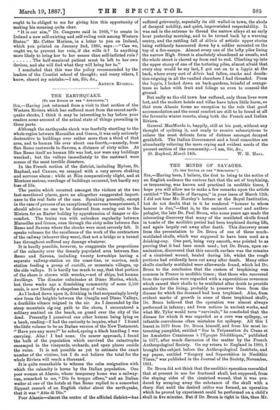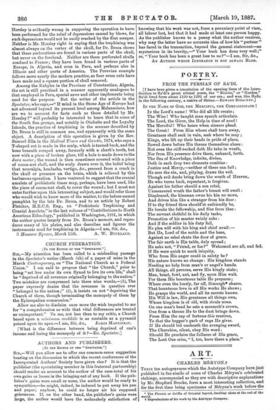THE MINDS OF SAVAGES.
[To TIM EDITOR OP TIM .8171071T011..] Suit—Having been, I believe, the first to bring to the notice of an English audience the curious fact that the art of trephining, or trepanning, was known and practised in neolithic times, I hope you will allow me to make a few remarks upon the article entitled "The Minds of Savages," in your issue of March 12th. I did not hear Mr. Horsley's lecture at the Royal Institution, but do not doubt that in it he rendered "honour to whom honour is clue,"—that is, to the eminent savant and anthro- pologist, the late Dr. Paul Broca, who some years ago made the interesting discovery that many of the mutilated skulls found in tombs of the neolithic period had been trephined. during life, and again largely cut away after death. This discovery arose from the presentation to Dr. Broca of one of these much- mutilated skulls, which was supposed to have been used as a drinking-cup. One part, being very smooth, was pointed to as proving that it had been much used.; bat Dr. Broca, upon ex- amination, discovered that this smooth surface was the remains of a eicatrised wound, healed daring life, whilst the rough portions had evidently been cut away after death. Many other skulls similarly mutilated were afterwards found, which led Dr. Broca to the conclusion that the custom of trephining was common in France in neolithic times ; that those who recovered from the operation were regarded with a superstitious reverence which caused their skulls to be mutilated after death to provide amulets for the living, probably to preserve them from the disease for which the deceased had been trephined. Also, from evident marks of growth in some of these trephined skulls, Dr. Broca believed that the operation was almost always performed in infancy; and from notices in ancient works, and what Mr. Tyler would term "survivals," he concluded that the disease for which it was regarded as a cure was epilepsy, or infantile convulsions often mistaken for epilepsy. All this I learnt in 1879 from Dr. Broca himself, and from his most in- teresting pamphlet, entitled " Sar la Trdpanation du Crane et lee Amulettes Craniennes is l'Epoque Neolithique," published in 1877, after much discussion of the matter by the French Anthropological Society. On my return to England in 1880, I brought the subject before the Anthropological Institute, and my paper, entitled "Surgery and Superstition in Neolithic, Times," was published in the journal of the Society, November, 1881.
Dr. Broca did not think that the neolithic operation resembled that at present in use for fractured skull, but supposed, frons the sloping sides of the eicatrised wound, that it was pro- duced by scraping away the substance of the skull with a sharp flint until the desired. orifice was formed, an operation which he proved by experiment could be performed on a child's skull in five minutes. But if Dr. Broca is right in this, then Mr.
Horsley is evidently wrong in supposing the operation to have been performed. for the relief of depressions caused by blows, for sash depressions would not be easily reached by the flint scraper. Neither is Mr. Horsley right in saying that the trephining was almost always on the vertex of the skull, for Dr. Broca shows that these perforations are found in various parts of the skull, but never on the forehead. Neither are these perforated skulls confined to France; they have been found in various parts of Europe, in Algeria, and even in Peru, and perhaps also in Illinois and other parts of America. The Peruvian example followe more nearly the modern practice, as four cross cuts have been made and a square portion of skull removed.
Among the Kabyles in the Province of Constantine, Algeria, the art is still practised in a manner apparently analogous to that employed in Pent, special saws and other implements being used for the purpose. But the writer of the article in the :Spectator, who says,—" If mind in the Stone Age of Europe had not advanced beyond its present level among Melanesians, how are we to account for facts such as those detailed by Mr. Horsley ?" will probably be interested to learn that in some of the South Sea gronps, and notably in Otaheite and the Loyalty Islands, the practice of trephining in the manner described by Dr. Broca is still in common use, and apparently with the same object. A description of this operation is given by the Rev. Samuel Ella in the Medical Times and Gazette, 1874, who says a T-shaped cut is made in the scalp, which is turned back, and the bone beneath scraped away, formerly with a shark's tooth, but now with a piece of broken glass, till a hole is made down to the dura mater; the wound is then sometimes covered with a piece of cocoa-nut shell, and the scalp drawn over it, the belief being that neuralgia, headache, vertigo, &c., proceed from a crack in the skull or pressure on the brain, which is relieved by this barbarous operation. I have ventured to suggest that the cranial amulets of prehistoric times may, perhaps, have been used, like the piece of cocoa-nut shell, to cover the wound; bat I must not enter further upon this interesting subject, and would refer those who would wish to know more of the matter, to the before-named pamphlet by the late Dr. Broca, and to an article by Robert Fletcher, M.R.C.S. Eng., on "Prehistoric Trephining and Cranial Amulets," in the last volume of "Contributions to North American Ethnology," published in Washington, 1831, in which the author quotes largely from Dr. Broca's memoir, and repro- duces many of his plates, and also describes and figures the instruments used for trephining in Algeria.—I am, Sir, &c., 3 Hanover Square, March 15th. A. W. BUCKLAND



































 Previous page
Previous page